 |
||||||||||||||||||||||||||||||||||||||||||||||||||||||||||
Many of you that fish the local club tournaments are aware that the DNR collects information about the fish you weigh in. Julie Vecchio was a graduate student working with the DNR and she had put together this informative document. |
||||||||||||||||||||||||||||||||||||||||||||||||||||||||||
| South Carolina Department of Natural Resources | ||||||||||||||||||||||||||||||||||||||||||||||||||||||||||
| "So, what ARE those crazy DNR people doing to our fish?" | ||||||||||||||||||||||||||||||||||||||||||||||||||||||||||
| The
inshore fisheries section of SCDNR keeps track of age, reproductive status,
and populations size of several recreationally important estuarine and near-shore
fish species in South Carolina. We do this through a variety of means. We do our own fisheries-independent sampling using both trammel nets and electrofishing techniques. We also have a freezer-fish program in which people leave the wracks of fish they have caught for us in freezers throughout the coastal area. In addition, we use structures from the fish you catch and bring into tournaments. It is important for us to examine all specimens brought in, not just the biggest ones. These species include: Red Drum Spotted Seatrout Southern Flounder Black Drum Sheepshead |
||||||||||||||||||||||||||||||||||||||||||||||||||||||||||
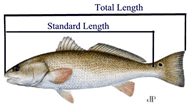 |
Fish
Lengths and Weights: Each fish is measured to the nearest millimeter for Total Length and Standard Length. It is then weighed to the nearest gram. |
|||||||||||||||||||||||||||||||||||||||||||||||||||||||||
| Otoliths: Otoliths are the internal ear bones of the fish. Every fish has 3 pairs of otoliths. Most of the time, scientists use the sagittal otoliths to age fish, mostly because they are the biggest and easiest to find, see, and examine under a microscope. |
||||||||||||||||||||||||||||||||||||||||||||||||||||||||||
| Otoliths
are calcium secretions within the head of the fish, and they grow as the
fish grows. Most fish grow through their lives. Therefore, their otoliths
grow with them throughout their lives. Each day, the fish lays down an extremely tiny layer of new calcium on the outside of the otolith. |
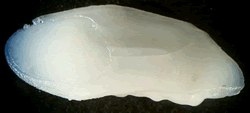 This is a whole otolith of a Spotted Seatrout |
|||||||||||||||||||||||||||||||||||||||||||||||||||||||||
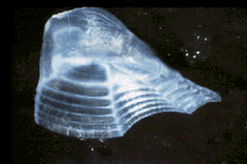 This is a sectioned Red Drum otolith. The space from one bright band to the next is counted as a year of growth. This fish is 7 years old. |
||||||||||||||||||||||||||||||||||||||||||||||||||||||||||
| Because
the fish that we care about live in coastal waters, they encounter seasons
where the water is warmer and seasons where the water is colder. Generally,
during colder months, the fish grow more slowly than during warmer months. The daily layers are laid down closer together during colder months. When examined as a whole, the otolith appears to have layers to it, one compact layer, followed by one diffuse layer. When examined, one compact layer, plus one diffuse layer equals one year of growth. one year of growth. |
||||||||||||||||||||||||||||||||||||||||||||||||||||||||||
| If
we examine enough of these otoliths, we can find out how old the fish within the population are. |
||||||||||||||||||||||||||||||||||||||||||||||||||||||||||
| Gonads | ||||||||||||||||||||||||||||||||||||||||||||||||||||||||||
| Most
marine and estuarine bony fish reproduce by getting together in large groups and spraying huge numbers of eggs and sperm into the water. When the eggs and sperm meet in the water column, they fertilize. However, each fish species reproduces during a specific time of year. Fish do not have external genitalia. This means that we cannot tell if they are males or females by looking at them from the outside. We must cut them open to find out if they are males or females, and to find out if they are able to reproduce. |
||||||||||||||||||||||||||||||||||||||||||||||||||||||||||
Female
gonad look like this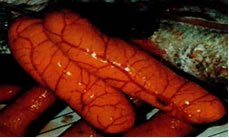 |
Male
gonad look like this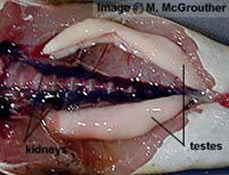 |
|||||||||||||||||||||||||||||||||||||||||||||||||||||||||
| Bringing it all together | ||||||||||||||||||||||||||||||||||||||||||||||||||||||||||
| By
putting this information together, we can tell how large the fish are within the population, how old those same fish are, and whether those individuals are able to reproduce. This is very important information for several reasons. First, it is important to know about the life history of fisheries species. This helps us to determine at what size and age they can be harvested from the population while doing the least amount of damage to future generations. In addition, we can tell whether a group of fish is in danger from overfishing. Classic signs of overfishing include fish that are smaller than they used to be at a certain age, and fish that are maturing earlier than they used to. If fisheries scientists notice these things about a species, they will know that the stock of fish is probably being overfished. If scientists are monitoring a species and notice that it is being overfished, they may be able to change harvest regulations and and prevent the species from becoming extinct. |
||||||||||||||||||||||||||||||||||||||||||||||||||||||||||
| Life histores of the fish we study | ||||||||||||||||||||||||||||||||||||||||||||||||||||||||||
| Red Drum | ||||||||||||||||||||||||||||||||||||||||||||||||||||||||||
| Red
Drum enter the estuary as eggs and are washed into shallow nursery areas
by currents. The spend the first few years of their lives living and feeding
within the estuary. Males become sexually mature between 3 and 4 years of age, 25 inches total length, and about 8 pounds. Females mature later, between 4 and 5 years of age, 30 inches total length, and about 10 pounds. Both males and females move out of the estuary into the ocean at about the time when they mature. |
 Red drum have been aged to over 35 years of age. All red drum within the slot limit are immature fish. |
|||||||||||||||||||||||||||||||||||||||||||||||||||||||||
| Spotted Seatrout | ||||||||||||||||||||||||||||||||||||||||||||||||||||||||||
Most spotted seatrout live to only a few years old. However, a few have been aged to over 10 years. |
Spotted
Seatrout spend their entire lives within the estuary. The adults spawn between May and August within the estuary, and eggs enter small nursery creeks. Spotted seatrout take approximately one year to mature. Both males and females are approximately 10 inches long and weigh about ½ pound when they become sexually mature. However, after this, females begin growing much faster than males. For example, a 3 year old female would be approximately 17 inches long and weigh about 2 ½ pounds. A 3 year old male would be approximately 15 inches long and weigh about 1 ½ pounds. This size difference continues throughout their lives. |
|||||||||||||||||||||||||||||||||||||||||||||||||||||||||
| Southern Flounder | ||||||||||||||||||||||||||||||||||||||||||||||||||||||||||
| Southern
Flounder spawn in offshore waters during the late fall, early winter months.
The eggs drift in offshore waters, hatching into larvae that are about ½ inch long when they finally get to shallow nursery areas within the upper estuaries. When they are tiny, flounder begin life looking like normal fish, with an eye on each side of their head. As they grow, the right eye migrates to the left side of the head. By about ½ inch long, they have both eyes on the left side of their head. |

Females grow rapidly and may reach 12 inches by the end of the first year. Males may be only 8 to 10 at one year. |
|||||||||||||||||||||||||||||||||||||||||||||||||||||||||
Julie...Thanks,
this is great information!...Janell |
||||||||||||||||||||||||||||||||||||||||||||||||||||||||||
|
||||||||||||||||||||||||||||||||||||||||||||||||||||||||||